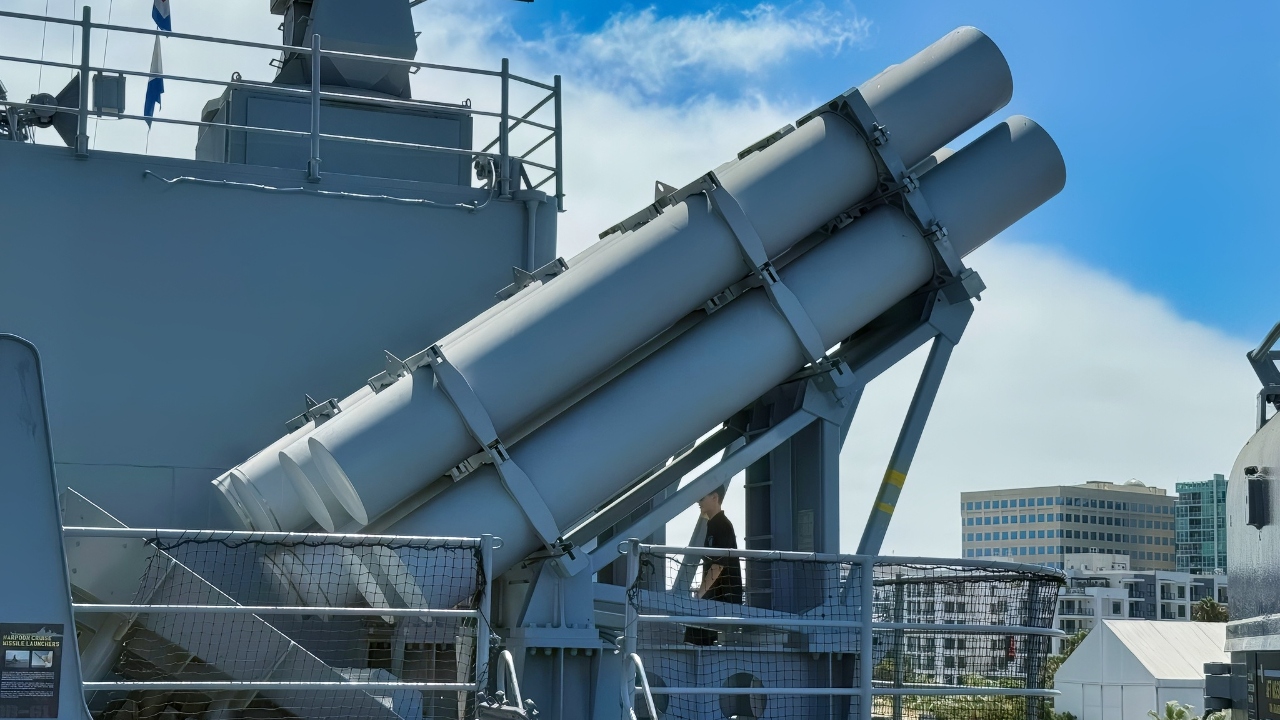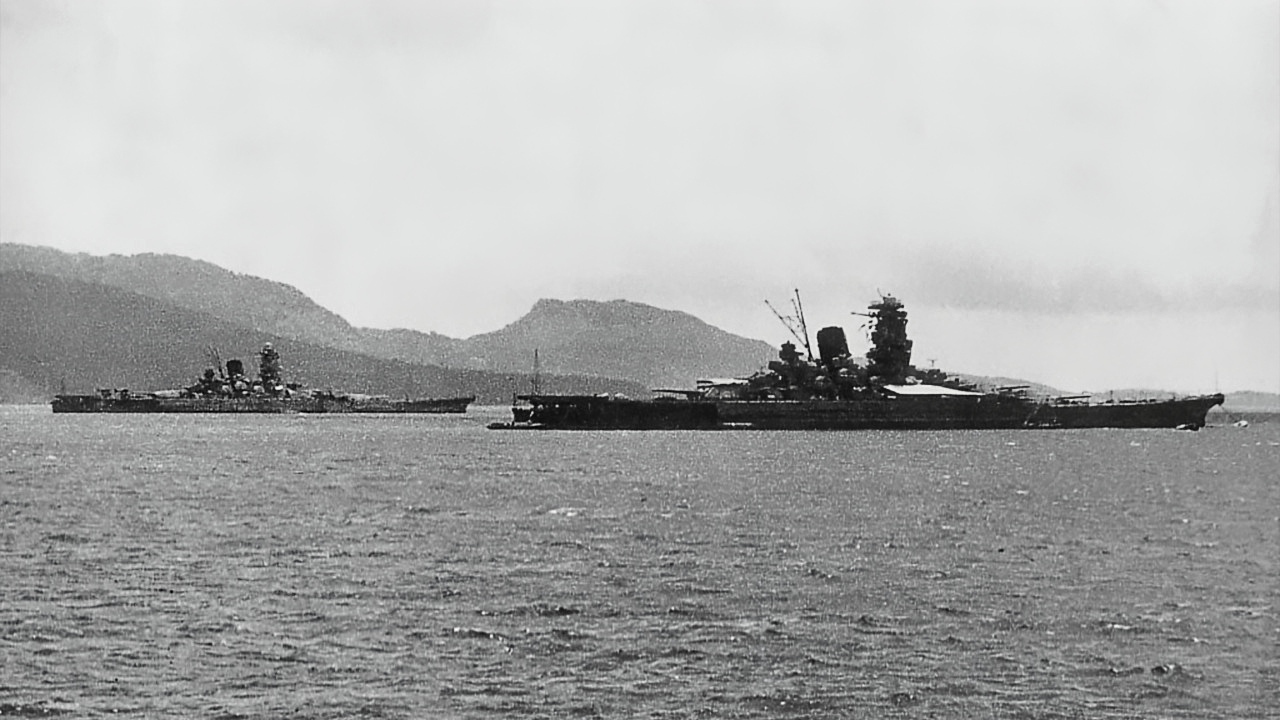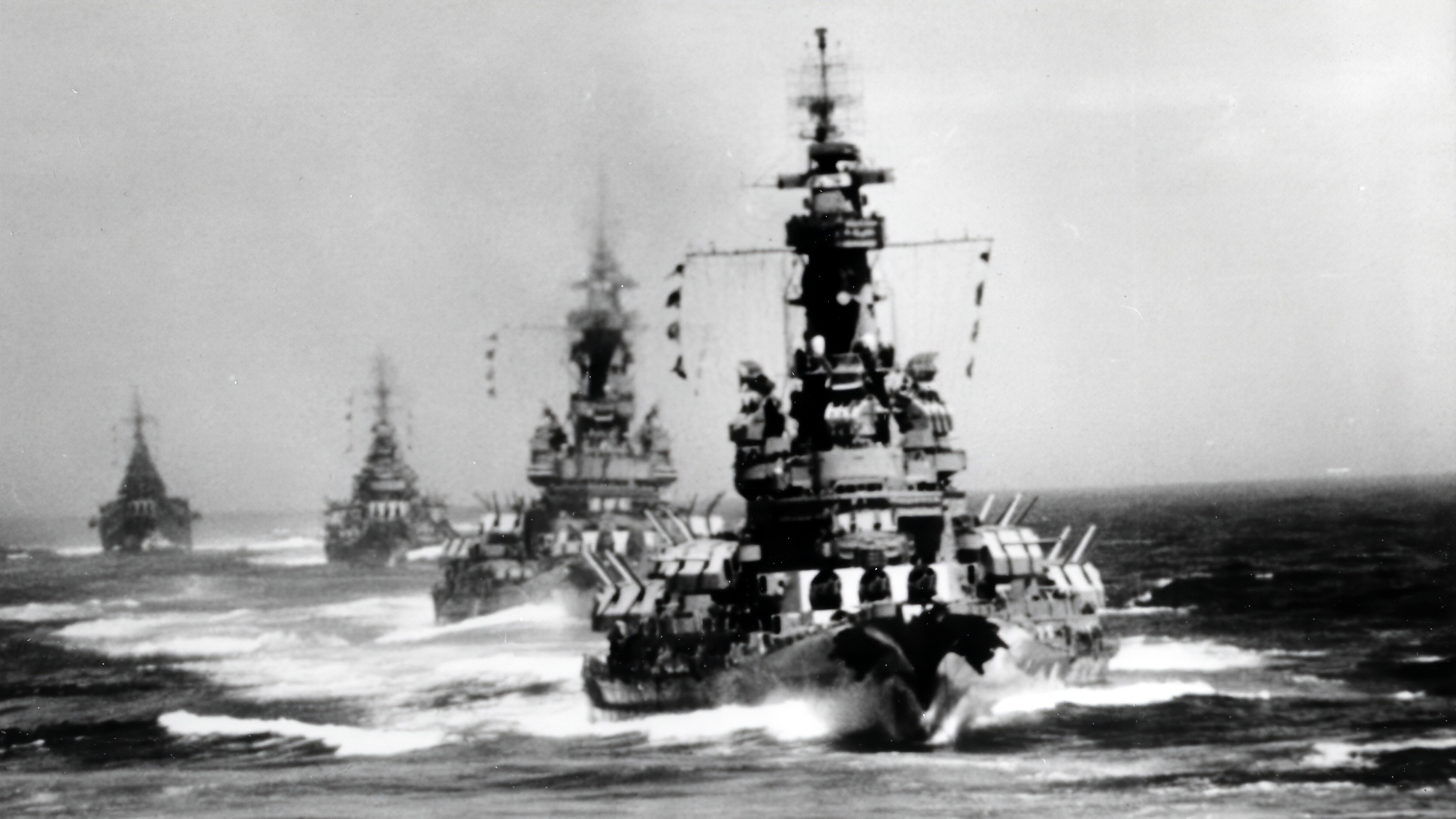Key Points and Summary – This essay profiles five battleship classes—Iowa, Yamato, South Dakota, King George V, and North Carolina—as strategic answers to the problems of their eras.
-Iowa fused speed, firepower, and adaptability from World War II through Desert Storm. Yamato was the apex of the “decisive battle” idea, outclassed by radar air power.

Iowa-Class Battleship Broadside. Image Credit: Creative Commons.
-South Dakota packed big guns and tough protection into a treaty hull and learned fast in night combat. King George V traded caliber for balance and delivered under fire.
-North Carolina pioneered the fast-battleship formula and became an AA guardian.
-Together they show how design, sensors, and doctrine—not just armor—decide what “best” means.
The Five Best Battleship Classes of All Time—And Why They Still Loom Large
After spending a considerable amount of time on the USS Iowa back in August (we also did reporting from the battleship USS New Jersey, as well), my perspective on what makes the best battleships has shifted slightly.
But, first, I should state the obvious: Picking “the best” battleships is a little like arguing over the greatest jazz records: a lot depends on what you value. I love Miles Davis, you might hate his work. So be it.
Is it raw tonnage and gun caliber?
Combat results?
Capacity to adapt as technology and doctrine shifted?
Rather than ranking them 1–5, this essay highlights five classes whose design choices and wartime performance have shaped naval history and continue to inform our understanding of sea power.
Together, Iowa, Yamato, South Dakota, King George V, and North Carolina classes tell a story that runs from treaty-limited ingenuity to fast-carrier escorts and, finally, to the twilight of big-gun ships.
What binds these five isn’t just steel and displacement. It’s the way each class solved a specific strategic problem of its era—sometimes brilliantly, sometimes imperfectly—and how those solutions rippled through the rest of the fleet. Read them less as museum pieces and more as hard-won lessons.
Iowa-Class: Speed as Protection, Firepower as Policy
The Iowa class answered a U.S. Navy question that predated Pearl Harbor: how do you keep up with fast carrier task forces, kill what threatens them, and impose your will along hostile coastlines?
The design bet on speed without surrendering punch—long, fine lines for 33 knots, nine 16-inch/50 guns, heavy armor intelligently distributed, and superb fire control. That speed wasn’t vanity; it was a survival tool. The Iowas could reposition quickly to screen carriers, intercept raiders, or appear off an enemy’s shore and hammer fortifications with shocking precision.

Iowa-Class Battleship Secondary Guns. Image Credit: Harry J. Kazianis/National Security Journal.

Iowa-Class Battleship National Security Journal Visit from August 2025. Image Credit: Harry J. Kazianis.
In action, they did all of that and more. In World War II they fenced with fast carrier groups, threw heavy bombardments ahead of amphibious assaults, and shrugged off punishment thanks to robust compartmentation and a torpedo-defense system that worked as advertised.
In Korea and Vietnam, they reminded the world what a 2,700-lb shell could do to bunkers and bridges. When the Cold War heated up in the 1980s, they came back with a new argument: battleships could be missile trucks and command platforms, slinging Tomahawks and Harpoons while still retaining their “big stick” for naval gunfire support. In 1991, Missouri and Wisconsin opened Desert Storm with cruise missiles and closed with 16-inch gunfire—an almost cinematic bookend for the type.

USS Iowa Harpoon Canister. Image Credit: Harry J. Kazianis/National Security Journal.
The deeper point is strategic flexibility. No other battleship class proved as adaptable across five decades and multiple conflicts. That’s why all four now sit as museum ships, not as relics, but as case studies in longevity born of clear design priorities: speed, firepower, and fighting margin.
Yamato-Class: The Boldest Bet on the “Decisive Battle”
Japan’s Yamato class was the most audacious expression of interwar Mahanian thinking: build capital ships so large and so heavily gunned that they could smash anything afloat in a single fleet action.

Yamato-Class Battleship from WWII. Image Credit: Creative Commons.

Yamato-Class Battleship. Image Credit: Creative Commons.

Yamato-Class Battleships Musashi and Yamato. Image Credit: Creative Commons.
Nine 46-cm (18.1-inch) main guns—the largest ever to go to sea—sat atop immense armor, with ammunition and machinery protected by deep belts and a layered deck scheme. On paper, Yamato and Musashi were the answer to a U.S. Pacific Fleet that Japan assumed would advance through island chains into a waiting trap.
Reality intervened. Industrial asymmetry, radar-directed air power, and the cumulative attrition of 1944 made the “decisive battle” less a matter of line-of-battle gunnery and more a multidomain contest of scouting, logistics, and strike timing. Musashi died under repeated carrier-air attacks in the Sibuyan Sea; Yamato’s last sortie, Operation Ten-Go, ended in an apocalyptic air onslaught short of Okinawa. None of this negates the class’s engineering achievement or the shiphandling skill of their crews. It does underscore a brutal wartime lesson: in the age of massed carrier aviation, surprise and saturation could erase even the thickest armor.
Yamato remains a paradox—both pinnacle and epitaph of the gun-armed capital ship. As engineering exercises, they were magnificent. As war-winning tools, they were eclipsed by the carriers they were meant to shield and slaughter.
South Dakota-Class: Compact, Treaty-Limited, and Tough in the Brawl
The South Dakotas are the U.S. “knife fighters”—treaty-bound 35,000-ton hulls that still carried nine 16-inch guns, stout armor, and excellent fire control, but in a shorter, more compact package than came before or after. Designers squeezed machinery into tighter spaces, adopted an advanced “all-or-nothing” armor scheme with refined internal arrangements, and delivered ships that could keep pace with carriers while standing in the line of battle.

Indiana leading Massachusetts and the heavy cruisers Chicago and Quincy shortly before the bombardment of Kamaishi on 14 July 1945. This photo was taken from South Dakota.
That balancing act paid off most vividly during the 1942–43 knife-edge months around Guadalcanal. USS South Dakota’s rough night at the Second Naval Battle of Guadalcanal—riddled by shells and electrical failures—often gets remembered for the damage report.
Still, the wider narrative includes the class’s resilience and the U.S. Navy’s learning curve on radar-directed gunnery. The same design qualities that made the ships compact also made their protection efficient: the citadel stayed intact, the ship survived, and the U.S. battle line learned how to fight at night with radar as a decisive edge.
Sister ships added their own chapters—Massachusetts (Fun Fact: I slept aboard this battleship when I was a kid with the Boy Scouts), dueling Jean Bart off Casablanca, Alabama guarding convoys, and then battering Japanese air and shore targets across the Central Pacific.
If the Iowas were thoroughbreds, the South Dakotas were prizefighters: powerful, surprisingly quick, and built to take a beating without going down.
King George V-Class: Britain’s Treaty Compromise That Still Beat the Tyrants
Britain’s King George V class is where policy and engineering compromise met operational necessity. Bound to 14-inch guns by treaty politics even as rivals leaned into 15s and 16s, the Admiralty compensated with armor, subdivision, and sophisticated fire control. Quadruple and twin turrets added mechanical complexity, but the package was seaworthy, well-protected, and—crucially—available when the Royal Navy needed it most.
That mattered in 1941–43. Prince of Wales helped corner Bismarck and landed damaging hits before her own loss later that year to Japanese aircraft underscored the rising primacy of air power. King George V and Duke of York went on to cover Mediterranean operations and, in Duke of York’s case, to end Scharnhorst at the North Cape in Arctic darkness—radar, persistence, and professional gunnery turning a frigid chase into a decisive kill. Howe and Anson rounded out the class’s portfolio with convoy cover and later Pacific duties.
The verdict? Not the biggest guns, not the fastest hulls—but a balanced wartime design that delivered where and when the United Kingdom needed steel results. The KGVs remind us that “best” sometimes means “best for the coalition strategy you actually have.”
North Carolina-Class: The First of the Fast Battleships—and AA Guardians of the Fleet
If the South Dakotas were the compact sluggers, the North Carolinas were the prototype fast battleships that set the U.S. template: speed suitable for carrier escort, nine 16-inch/45s, and a hull form that absorbed treaty limits while anticipating their collapse. Early teething issues—most famously propeller-induced vibrations—were solved, and the ships matured into reliable fleet companions with heavy anti-air batteries that turned them into AA umbrellas around the carriers.
USS North Carolina’s quick repair and return after a 1942 torpedo hit sent a signal: these ships could take a punch, self-rescue, and keep fighting. Both North Carolina and Washington then spent most of their war pushing westward, guarding carriers, smashing shore targets, and—at Guadalcanal—showing how radar-directed main batteries could decide a night battle in minutes. Their sustained AA contribution across the Pacific often gets less ink than the big-gun moments, but ask any aviator flying from a flattop in 1944 which silhouettes they liked to see off the starboard quarter, and you’ll get the point.
As a design bridge to the South Dakotas and then the Iowas, the North Carolinas earn their place by being first—and by proving the concept worked under fire.
What “Best” Really Means: Context, Adaptation, and Proof
It’s tempting to turn “best battleship” into a pure spreadsheet exercise: biggest guns, thickest belt, longest range. The more defensible metric is how a class performed against the jobs it was designed to do—and how gracefully it adapted when the jobs changed.
Iowa nailed the “fast escort and coercive bombardment” brief and then reinvented itself as a missile-and-gun power projector in the late Cold War.
Yamato embodied a prewar doctrine whose assumptions died in 1944—an engineering masterpiece that arrived in the wrong tactical universe.
South Dakota proved that smart armor, radar, and compact power could win at brawling distance and live to tell the tale.
King George V showed how treaty limitations don’t preclude battlefield impact when married to radar, training, and operational nerve.
North Carolina pioneered the U.S. fast-battleship formula and served as the indispensable AA guardian of a carrier-centric Navy.
The other lesson is sobering. Even the “best” battleship could not outrun the logic of air power and, later, guided weapons. Many of the class-defining triumphs above—Bismarck, Scharnhorst, Kirishima— hinged on sensors, networks, and timing as much as metallurgy.
In that sense, these ships are less monuments to armor than mile markers on the road to modern, networked sea control.
About the Author: Harry J. Kazianis
Harry J. Kazianis (@Grecianformula) is Editor-In-Chief and President of National Security Journal. He was the former Senior Director of National Security Affairs at the Center for the National Interest (CFTNI), a foreign policy think tank founded by Richard Nixon based in Washington, DC. Harry has over a decade of experience in think tanks and national security publishing. His ideas have been published in the NY Times, The Washington Post, The Wall Street Journal, CNN, and many other outlets worldwide. He has held positions at CSIS, the Heritage Foundation, the University of Nottingham, and several other institutions related to national security research and studies. He is the former Executive Editor of the National Interest and the Diplomat. He holds a Master’s degree focusing on international affairs from Harvard University.
More Military
Canada Is ‘Full Steam Ahead’ on F-35 Stealth Fighter
Why Does Turkey Have So Many Main Battle Tanks?
‘Cracked Barrels’: The U.S. Navy’s Big Railgun Failure Explained in Just 2 Sad Words
‘Had No Chance’: The Montana-Class Was the 71,000-Ton Battleship Destined to Fail
‘Captain, We Smacked It Another Submarine’: British and French Nuclear Missile Subs Collided










